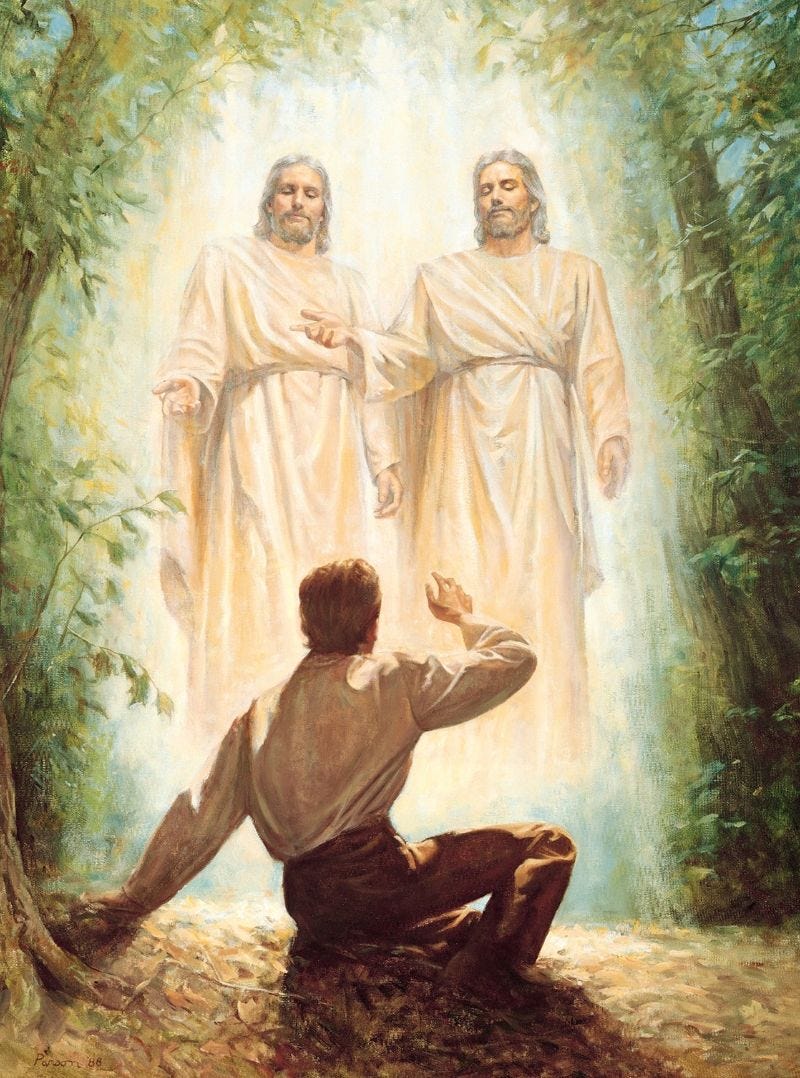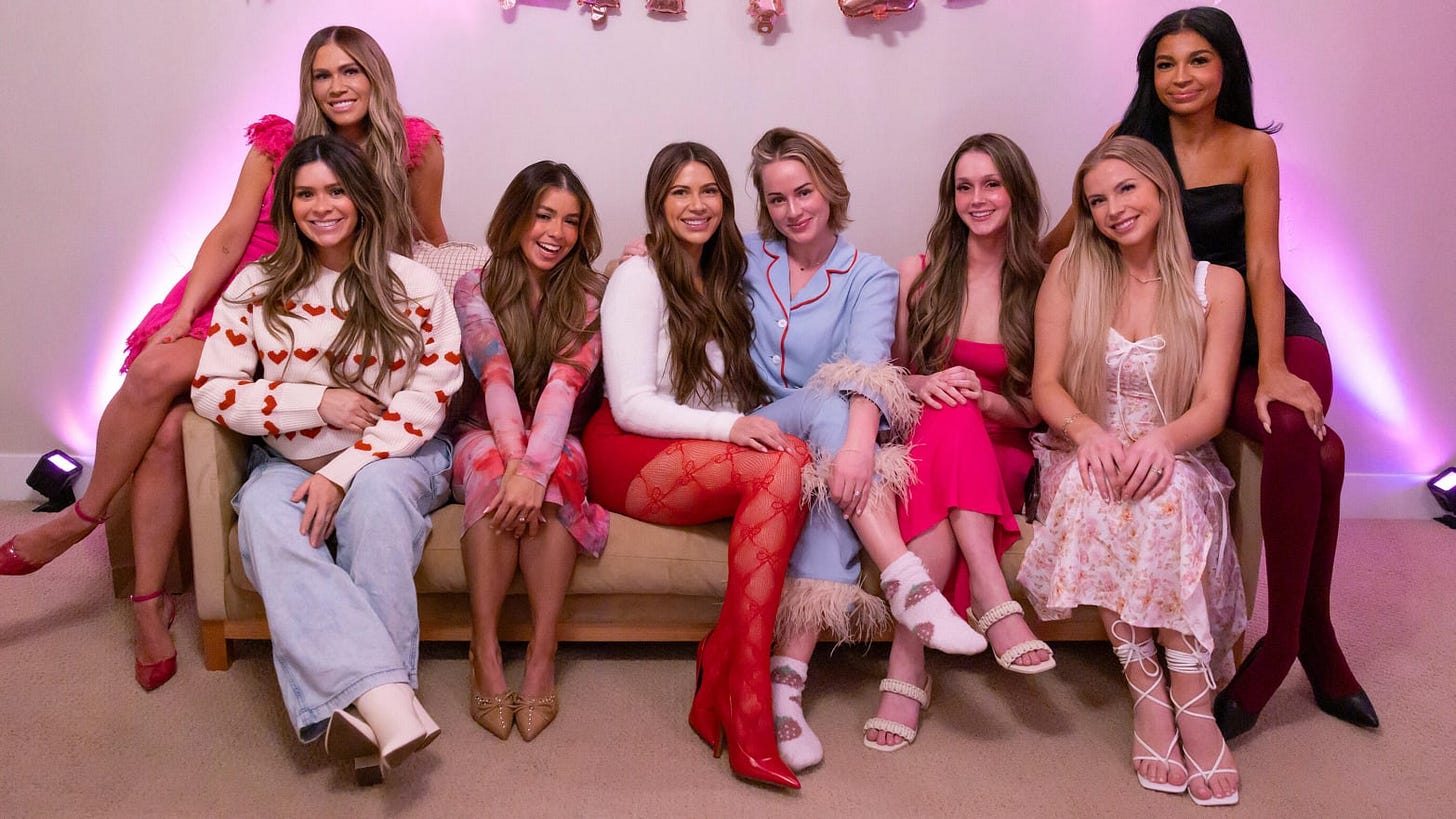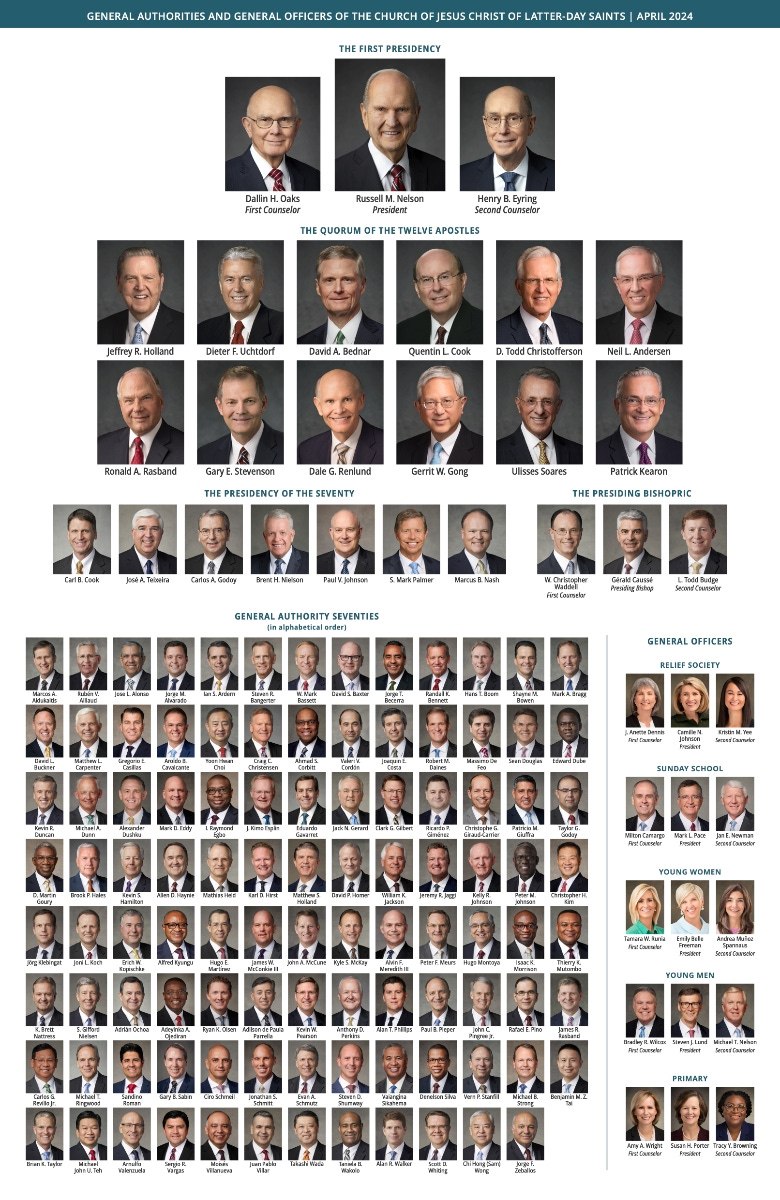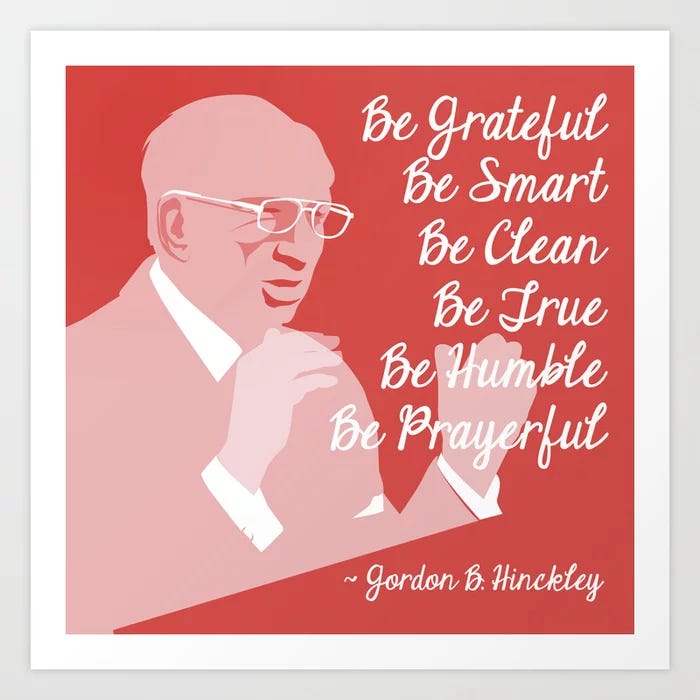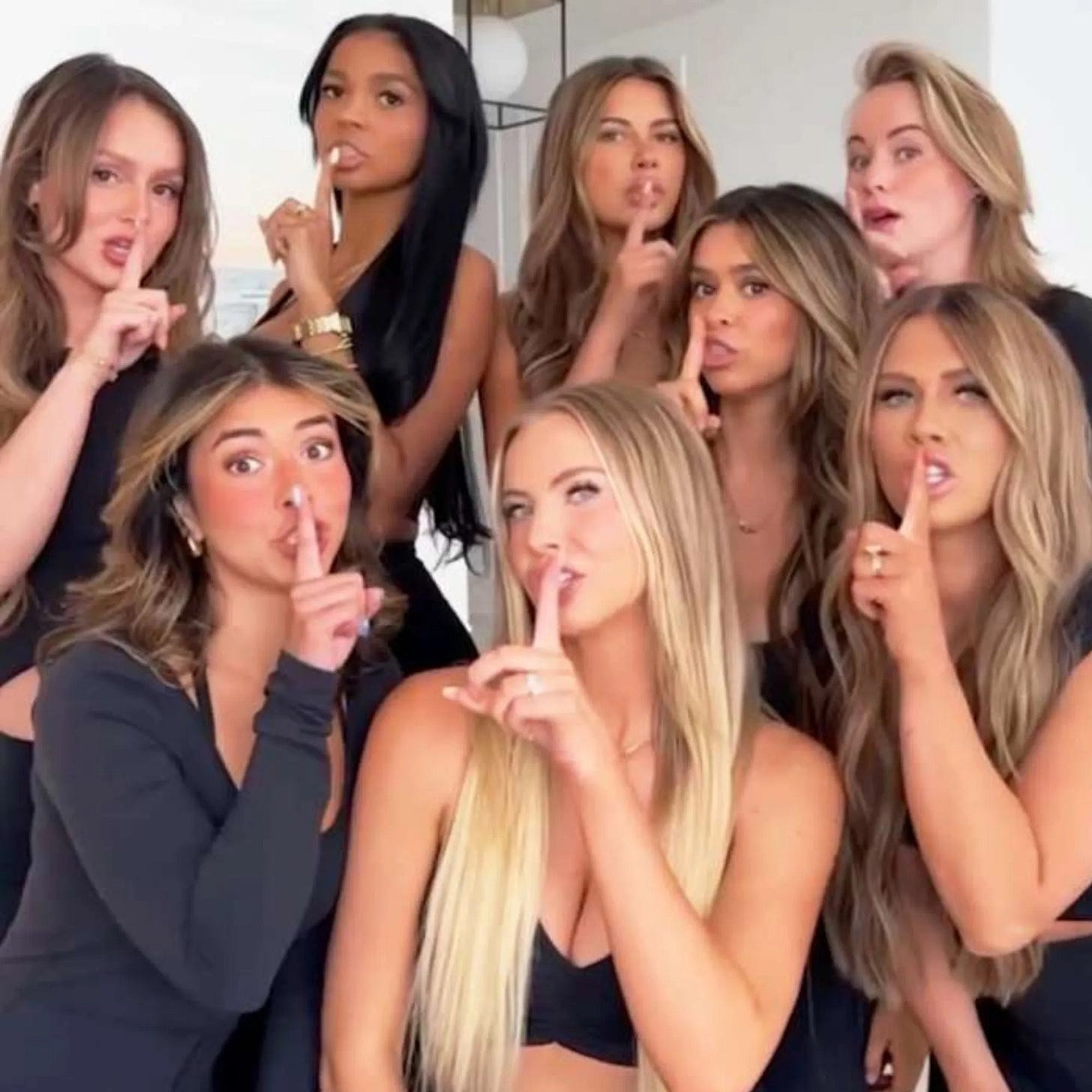The Secret Lives of Mormon Wives, what I think, and why you keep asking if they're Mormon or not
As my friends' resident expert on The Church of Jesus Christ of Latter-day Saints, I am moved by the spirit to give my thoughts on the show as well as address some questions some of you might have
In 1820 in the Great Lakes region of New York, a teenage boy named Joseph Smith, swept up by the fervor of the Second Great Awakening, walked into the woods to pray. He’d been going from church to church, traveling preacher to traveling preacher, to figure out which religion was the right religion. Which church was the true church. As the story goes, when he fell on his knees, a pillar of light descended from heaven, and two personages appeared before him: God the Father and Jesus Christ. They chose this teenage boy to restore Christ’s original church to the earth which had been lost for thousands of years. It would come to be known as The Church of Jesus Christ of Latter-day Saints.
Then, absolutely nothing happened to the church for 200 years until The Secret Lives of Mormon Wives premiered on Hulu on September 6, 2024.
As the resident Mormon1 expert in my friend groups, I was approached to give my thoughts on the show—is it accurate? Have you been to any of these places? What’s with all the soda? Are these women real?
Reality TV’s editing spares no one and the women of MomTok did not escape unscathed, but what surprised me most is how familiar these strangers were, amid the contortions of reality production.
Like most members, I was born into this church. If you trace my family tree back on all sides (which you can do conveniently, because Mormons consider genealogy to be a duty), you’ll find that every ancestor of mine in the 1830s and 1840s heard about Joseph Smith’s best selling Book of Mormon, hopped a boat, train, or wagon and joined up on the journey to the American West to spread the Gospel and settle Mormon towns.
With such a hearty, stocky, Saintly lineage, you’d expect me to be more true to the faith, but I’ve wrestled with the questions of God and Jesus and Joseph Smith and a church that bans gay marriage since I was a child. I left the church for the first time when I was 14. I joke that I “relapsed” back into the church when I was 25 shortly after meeting the loveliest sister missionaries in the world (whom I’m still close with)—and spent 18 months active again. I was determined to be a radical liberal Mormon and change the church from the inside. Spoiler alert: I did not succeed. But amid my heartbreak that I, a lone feminist, could not reform a 200 year old patriarchal church-slash-200-billion-dollar-corporation on my own, I was reminded what I have always loved most about the church—
The women.
The Secret Lives of Mormon Wives follows the lives of eight Mormon content creators2 who got their start on TikTok during the 2020 pandemic. Taylor Frankie Paul is credited as the founder of MomTok, but like most movements, the origins and original leadership stories are murky.
The 2020s have been the Mormon Mom Influencer Era, from MomTok, to Ballerina Farms, to Nara Smith, but their success can all be traced to the writers, bloggers, and moms who have been honing the craft for years. Whether it was the original Julliard ballerina turned mommy blogger Naomi Davis, plane crash survivor Stephanie Nielsen, journalist/enemy of Tim Ballard and therefore my hero Meg Conley, or prolific Twitter thread composer Design Mom Gabrielle Blair, Mormon women have been blogging, photographing, and making content since the genesis of the internet, from listservs to Blogger to Pinterest. How firm a foundation! They walked so MomTok could run.
We meet the MomTok crew when original group member Whitney Leavitt returns to Utah revealing that her husband has been unfaithful, and Taylor learns she is experiencing a miscarriage.
Together, the Moms go through daily life along with some more contrived activities, ranging from baby showers to graduation parties to a trip to Vegas complete with a Chippendale’s show, culminating in the launch of Mayci’s business. To the regular reality TV show fan, these are the perfunctory chain of events in a standard season. To most members of The Church of Jesus Christ of Latter-day Saints, events like baby showers and baby blessings are standard, if not weekly, occurrences—but tattoo brush ups, divorce parties, going to bars, and male entertainment shows are uncommon at best.
“Can MomTok survive this?”, the through-line of the series, was instantly meme-ified across the internet.
Will MomTok survive the show’s scandals, and arguments, and drama? Some of the scandals pre-date the program, like the “swinging scandal” created by Taylor Frankie Paul, but other issues arise throughout the course of the show: Taylor is arrested, Whitney makes an uncouth joke to Demi about a sex story, Jen uninvites Jessi and Demi from her baby’s blessing, and so on.
Can MomTok survive the day-to-day? Can MomTok survive the manipulation of reality TV show producers?
“Once the whole [swinging] controversy blew up, no one really knew what MomTok stood for anymore,” Mayci says. “Like, is it just a bunch of swingers, or are we a bunch of Mormon women fighting the patriarchy?”
MomTok is a content creating machine, but do they have standards and values? Is MomTok actually a group promoting female empowerment, even so far as fighting the patriarchy?
I think so, yes. They’re shaking up the norms of their very patriarchal church and agitating the conservative culture they live in:
The MomTok Moms are the primary breadwinners of their families, in direct opposition to the advisement of The Family Proclamation which states that “by divine design,” fathers “are responsible to provide the necessities of life and protection for their families.”
The MomTok Moms hire nannies, babysitters, and outsource domestic labor when they desire.
The MomTok Moms aren’t afraid to use sex toys to seek pleasure with and without their partners. (And Whitney subsequently had the most Mormon moment ever with her mom and sister, baking cookies and having awkward sex talks.)
The MomTok Moms don’t always wear their garments or dress by Mormon modesty standards and guidelines.
“We’re about empowering women. We’re about being strong, and standing up for ourselves.”
-Mayci, Episode 7
The MomTok Moms are defining who they are, who they want to be, how they want to do it, and are financing it themselves. For members of a church that teaches gender roles and compliance, this aberration is significant.
The Church of Jesus Christ of Latter-day Saints is presided over by men who hold the priesthood, but if you want something done, you should call in the women.
The Relief Society is the name of the women’s organization of the church. All women ages 18+ are automatically members, and they meet every other Sunday after the first hour of church (Sacrament Meeting) for a lesson, sharing spiritual thoughts, and planning—always planning. Any time the Relief Society gathers, calendars and sign up sheets and birthday cards are all passed around—everyone sets out to:
Feed the missionaries
Feed whoever is sick
Help the elderly couples in the ward
Cook for whatever event is happening this weekend
Organize the packing effort for a family’s move
Welcome the new family into the congregation
Chaperone the dance for the teenagers
Clean the church
Lend a hand at the kids’ activity
Plan the conference coming up
Sing in the choir
And do it all while looking beautiful.
Yes, the men are also given sign up sheets and expected to host, and do, and yes, it takes everyone to get a job done, but when I think back on activities and events and programming my entire life, the point person was always a woman.
Men preside over the church, but women run the church. Women raised the church. Women raised me. And Mormon women continue to raise me.
We never get to see MomTok Moms attending church, but we get glimpses of how they interact with it, from Whitney getting ready for church on a Sunday, prayers over meals, the blessing for Jen’s baby held at her family’s house.
The church does not allow outside media inside its doors (with extremely rare exceptions), so if the Moms of MomTok are attending weekly church meetings and activities, we know why these moments aren’t captured by cameras.
The weight and pressure of membership is immense.
As a church member, you exist in a sort of fishbowl. When your peers learn of your status, they inundate you with questions, ranging from the number of wives your dad has (13, and my mom’s the favorite), to if you wear the funny underwear or not (the funniest underwear, it has Garfield the cat on it), if you go to church at the nearest temple every Sunday (I go to church at the church and go to the temple at the temple, but better luck next time!) and if you’ve seen The Book of Mormon Musical (I haven’t been able to get tickets because all of the rich non-Mormons have bought them all, but thanks for rubbing salt in the wound.)
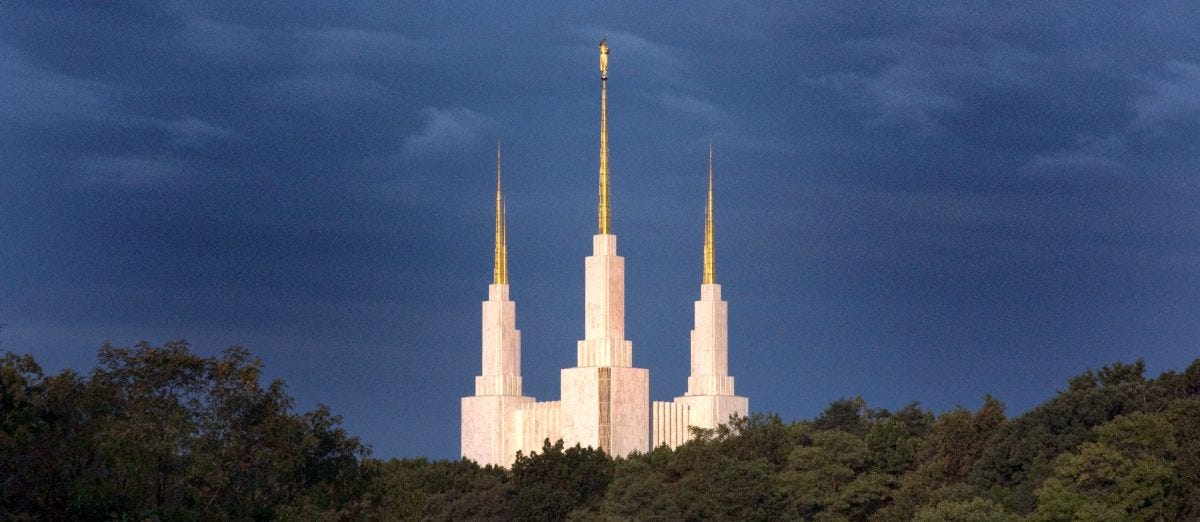
From childhood onward, you’re taught to be a shining example, to follow the written and unwritten rules, to be a walking advertisement for the church.3
To be so great that your testimony will strengthen and grow every day.
To be so great that you will be a strong member in the church.
To be be so great that you will reach the highest level of exaltation in heaven when you die (because there are three levels, and God only dwells in the highest.)
To be so great that your entire family reaches that highest level of exaltation, because while Families Can Be Together Forever, it’s only through Heavenly Father’s Plan, and His plan is for you to be great.
You are meant to be so good, so great, so happy, so whole, that others will crave your light and your countenance and your joy—and it will guide them to God. It will gather the lost sheep, it will gather the lost tribes of Israel, and we will all dwell in the Celestial Kingdom together for time and all eternity.
This church was woven together under the fervor of Manifest Destiny and American Exceptionalism. You made it to the promised land. So go forward and spread the word of God. Be the city upon a hill. You must be the best.
So you make and keep sacred covenants. You pay tithing. Attend the temple regularly. Read the scriptures, sing the hymns, listen to the words of the prophet. Stay on the covenant path. Reach out to others. Every member a missionary.
You are an elect son or daughter of Heavenly Father chosen to live in these Latter-days.
You are great. Be great.
It’s a lot to carry, and members are burning out in a myriad of ways. How can any one person be expected to do all this, carry all this, be all this?
Maybe there’s a way where members don’t have to do all things, be all things, hope all things, but they can still be, and they can still be Mormon.
My mom calls it being a “Cafeteria Plan Mormon,” where you take what matters and is meaningful and is beautiful to you while you leave behind what’s painful and hurtful and impossible—the way you take the food you want and leave behind the rest on a cafeteria line, albeit slightly higher stakes.
This idea is threatening to those who believe that the church and the gospel and its tenets and rules (written and unspoken) are all-or-nothing. On the other hand, it’s liberating and welcoming to those who want as many people as possible under Big Tent Mormonism.
The liberation is where I see the MomTok Moms—on the Cafeteria Plan—defining what it means to each of them to be a Mormon, defining what it means to be a mom, defining what it means to be a wife, defining if MomTok can even survive this.
“We don’t have to look or act or be a certain way to be the perfect wife. This is why the sisterhood of MomTok was created in the first place. We don’t want anyone to feel alone—we want them to have that support that not a lot of women have.”
-Demi, Episode 7
Unsurprisingly, most of the commentary surrounding The Secret Lives of Mormon Wives since its release has been on whether or not its stars are “actually” Mormon and whether or not they represent Mormon women.
I did fall privy to this discourse initially, looking for the primary Mormon identifiers, ignoring Cafeteria Plans, seeing these definitions as all-or-nothing.
Where are their garments? They’re not wearing them?! That woman just said the F word while holding what looks like it might potentially have coffee in it, and that woman is pregnant without being married! Cancel, cancel, cancel!
I was vaguely familiar with Taylor from some of her TikToks in 2020—I was suspicious she was using the label for Mormon for clicks—so I pried. I was skeptical—“no real Mormon woman shows her midriff that much!”—I thought I very cleverly sniffed an imposter out.
There’s no way she’s Mormon. She’s not Mormon.
Except, who the hell am I to say this?
I was born into the faith (called being “born in the covenant”), and before I became an “official” member of the church by being baptized, I was Mormon. Even after having left the church, I still consider myself Mormon in some capacity because the bonds of heritage and history are too strong to ignore. (I didn’t pay tithing as a little kid to rescind my joint ownership rights to buildings like this.)
There are several key milestones when someone’s membership in the church is finite and resolute—we can assume at those moments they are certainly Mormon:
Baptism and confirmation
Receiving a temple recommend (a card/license/permission slip stating you are worthy) to go through the temple
Receiving your endowments (making sacred covenants with Heavenly Father the first time you go through the temple—this is when you receive your temple garments)
OR,
Being excommunicated—at that point you are most assuredly not a member of the church
What happens in those in-between spaces?
There are many, many rules in The Church of Jesus Christ of Latter-day Saints, but it takes diligence to break enough of them to finally be excommunicated.
Some church members believe in exact obedience, but actual adherence followed will vary from person to person. So when is someone officially “in” or “out” of the church?
If someone goes inactive for 20 years and goes back to church one Sunday, do they get to call themselves Mormon again?
When I went to church every Sunday and had leadership roles and planned weekly activities but didn’t believe most of what I was reading, speaking, or teaching, did I have any right to call myself Mormon? Do I have any right to call myself some kind of Mormon now, however distant the relation is?
Whatever the case, it should be left up to the individual, because if not, it’s left up to strangers on Facebook. It’s left up to men in suits sitting in locked boardrooms in church-houses and office buildings. And it’s left up to television producers.
The Hulu producers are the ones orchestrating storylines, the promotions, the images, the music, the advertising—it is through their lens and their understanding of “Mormon” that we see these the Moms of MomTok, or, what they want us to see.
In the process, the producers showed us they were wholly unfamiliar with the most basic of Mormon symbolism and iconography. The simplest, easiest things to learn about the church and culture were missed by the producers. If the producers couldn’t learn how to differentiate between a Mormon church and a mainline Christian church, how could they differentiate between what makes a person uniquely Mormon or not, especially when there is such a large spectrum?
The Church of Jesus Christ of Latter-day Saints is incredibly unique in its identity in that it’s profoundly American. The Book of Mormon tells a story of a family from Jerusalem who is told by God to leave because the city will be destroyed—so they cross the Atlantic Ocean and land in the Americas. It’s a book full of war, family strife, faith, wisdom, and a lot of verses that start with “and it came to pass.” Also, Jesus shows up! (I don’t mean to spoil the book, but Jesus showing up is the really good part.)
In its 200 year history, the church has produced a visual identity that sets it apart completely from other Christian sects, starting with the fact that Mormon churches never use crosses or crucifixes.
For us, the cross is the symbol of the dying Christ, while our message is a declaration of the Living Christ. … Because our Savior lives, we do not use the symbol of His death as the symbol of our faith. But what shall we use? No sign, no work of art, no representation of form is adequate to express the glory and the wonder of the Living Christ. He told us what that symbol should be when He said, “If ye love me, keep my commandments”
The editing of The Secret Lives of Mormon Wives mishmashes together b-roll videos of the Wasatch Mountains, a couple of Mormon temples and chapels, and generic Christian churches and crucifixes, as though someone typed “Christian” into Getty Images for stock footage. This is set to the show’s theme song, an operatic choir overlaid with a sultry voice inviting “Listen up, I'm the one you've been dreaming of, I've got everything you could ever want…”
One Reddit user called this the “royalty-free version of ‘Unholy,’” the song by Sam Smith and Kim Petras used in the trailer for the program—but fans’ search for the title, singer, and lyrics of the theme song have lead to the hilarious confusion of the first line of the theme song (“Come ye saints and come ye sinners / Hallelujah”) with the definitive Mormon hymn, “Come Come Ye Saints” which shares no resemblance to The Secret Lives of Mormon Wives’ theme songs aside from the beginning words “come ye saints.”
When the producers, who have no connection to the church or its history, posit themselves as authority figures with the power to shape Mormon stories, they fall flat on their faces.
Below are images used throughout the show meant to depict “Mormonism” to the viewer, which have no relation to a Mormon church.






In Mormon churches, you will not find crucifixes, chalices, holy water, incense, rosaries.
In contrast, you can compare distinctly Mormon icons and images which include (but are not limited to)
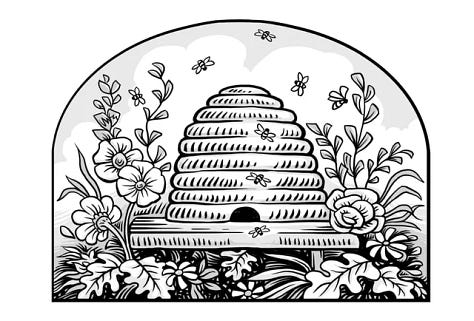
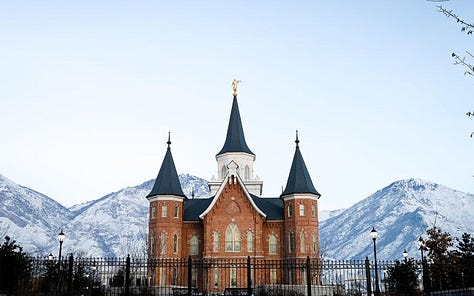
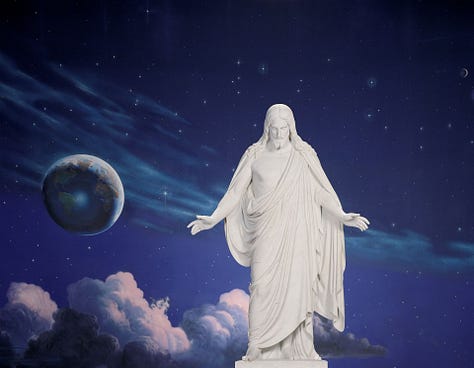
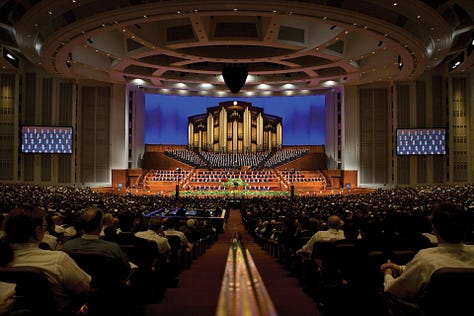
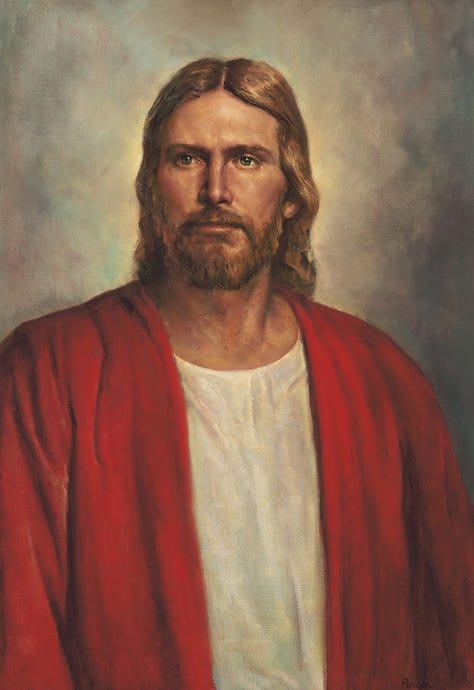
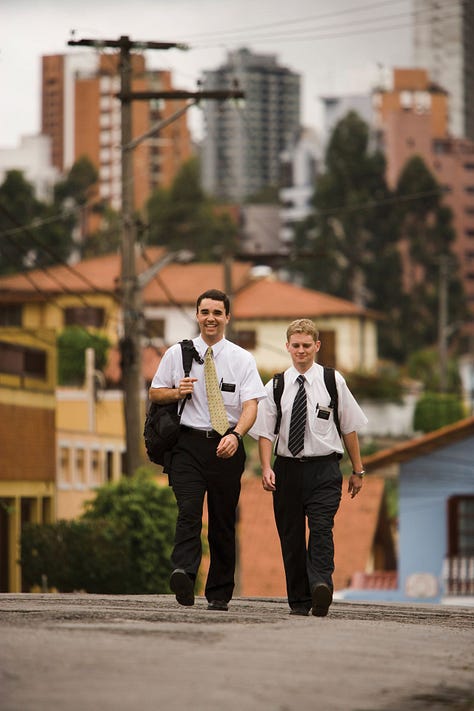


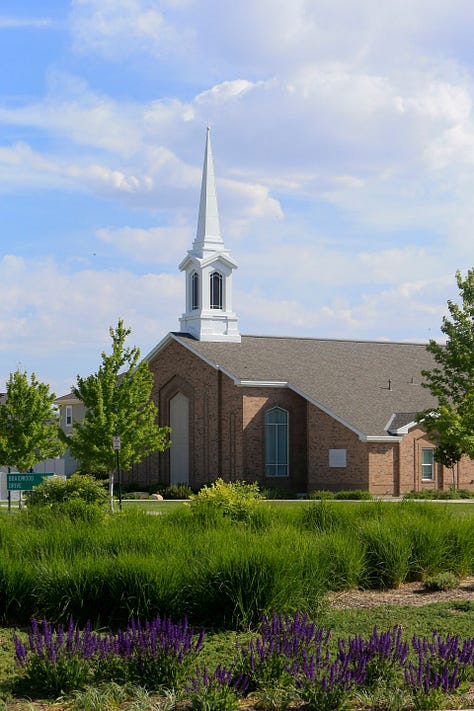
You will find spires towards heaven, oil paintings, beehives representing the church’s belief in hard work, together. You will find White Jesus, you will find reproductions of a Lutheran statue of Christ (now featured on the church’s new logo), you will find the same wall treatments, the same fabrics, the same paintings in every church.
In August, before the show premiered, the church released a statement condemning the show (without naming it)
We understand the fascination some in the media have with the Church, but regret that portrayals often rely on sensationalism and inaccuracies that do not fairly and fully reflect the lives of our Church members or the sacred beliefs that they hold dear.
Since the program has appeared, Facebook posts have been shared, petitions have been circulated, op-eds written, about the inaccuracy of the show and its portrayals. In the progressive Mormon and post Mormon sphere, podcasts and TikToks have been recorded—
This doesn’t represent me.
This does represent me.
This is completely inaccurate.
This is wholly accurate.
Who decides which one is right?
The Church simultaneously compels its members to speak in church, bear their souls and their testimonies, write in journals for posterity, share goodness on social media, be a light, spread the gospel, but do it correctly.
Use the church’s canned language of belonging. Quote the scriptures and the prophet. Follow the templates, fit in the model, look like a model, #ImAMormon.
I sense a desperation in the Moms of MomTok to not just have a voice but to be understood, to not be misconstrued, and to do something for themselves.
This is a reality TV show. These stories have been edited, curated, and manipulated—but in them I still see real women.
I don’t personally know the women of MomTok, but in them I see memories of girls I grew up with at church—a girl who begrudgingly showed up to activities because her parents forced her, a girl who weaponized her devoutness, a girl who barely spoke but played piano beautifully, a girl who called me ugly on MySpace, and a whole lot of girls who were so kind and so pretty that I felt nervous to just talk to them. I grew up with all of these girls, and I myself was many of these girls—imperfect girls who grew up into imperfect women, who are just trying. I like them for who they are, for what they’ve been through, and for the collective identity we share.
The Secret Lives of Mormon Wives is a contradiction—a mix of familiar, customary American Mormon stories (soda shops! botox! graduation parties!) with more contrived, but still possible, ones (Chippendale’s! bar hopping!) shabbily edited together with images that don’t even accurately depict the background of the very real characters.
The truth of the lives of Mormon women and wives is that they will spend their lives under a microscope, or on a pedestal, in a fishbowl, while carrying their families, friends, and communities on their backs. They will be misunderstood and misidentified, largely while those around them profit from their labor. But they endure to the end, because family, and friends, and eternity are their end goals—and they are brave enough to modify the plan if need be.
I see these women, and I love them.
In 2018, President Russell M Nelson issued a statement that members and the general public should only refer to the church by its official name, The Church of Jesus Christ of Latter-day Saints, rather than what it’s been colloquially known as, the Mormon Church. This includes referring to church members as “members of the Church of Jesus Christ of Latter-day Saints” rather than Mormons which has historical roots of being used derogatorily. Nelson’s call for action is in stark contrast to President Gordon B Hinckley’s 1990 talk, “Mormon Should Mean ‘More Good’” and the church’s 2011 #ImAMormon campaign, but President Nelson’s actions came as no surprise to most as he has calling for this for years.
Many members and former members of the church continue to use the term Mormon as an identifier, both for the sake of clarity but also as a personal claim to historical roots and identity. I use the Mormon name and identifier and intend it with the upmost respect.
MomTok’s TikTok Handles — Taylor Frankie Paul (@taylorfrankiepaul), Demi Engemann (@demilucymay_), Jennifer Affleck (@jenniferaffleckk), Jessi Ngatikaura (@_justjessilli), Layla Taylor (@laylaleannetaylor), Mayci Neeley (@maycineeley), Mikayla Matthews (@mikaylamatthews), Whitney Leavitt (@whitneyleavitt)
The church has a very healthy advertising budget, and BYU is one of the top schools for advertising in the country, but the church will take whatever it can get in terms of free marketing. Boots on the ground!





